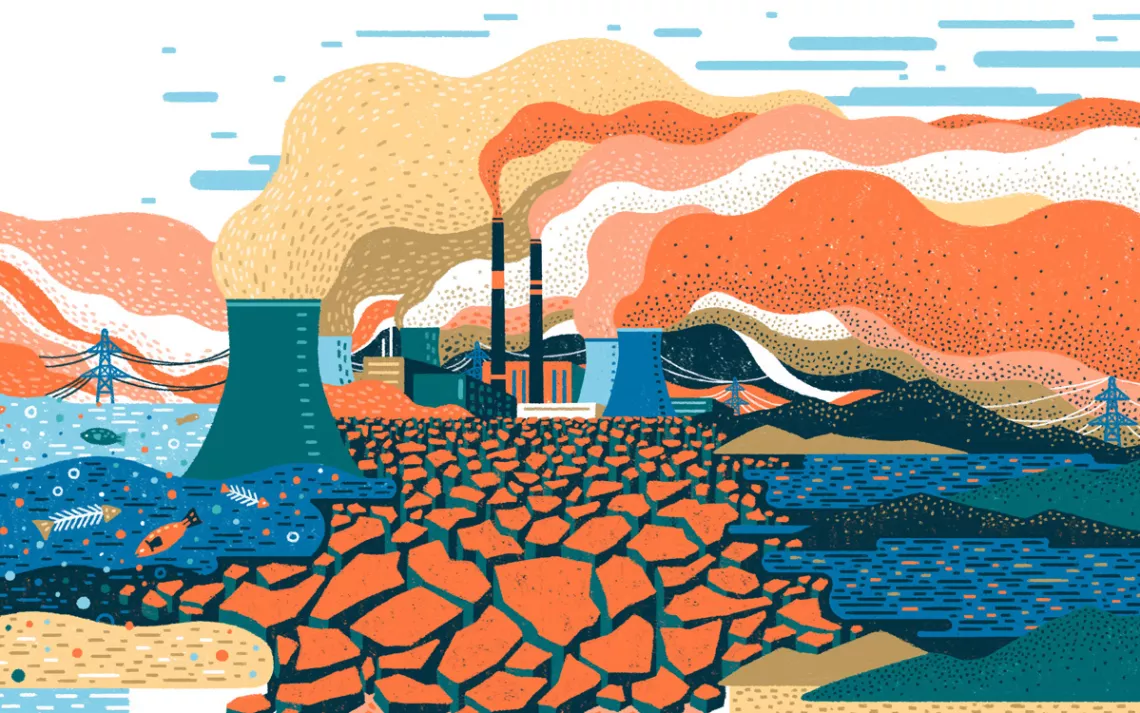Making Electricity Often Requires Steam—and That's Bad News for Rivers
Most of our modern power plants are basically little more than steam engines

Illustration by Yukai Du
Pop quiz: Which industry is responsible for the greatest volume of freshwater withdrawals in the United States? If you guessed agriculture, you guessed wrong. The correct answer is energy generation.
On an average day, U.S. power plants use about 161 billion gallons of water. They're responsible for 41 percent of all freshwater withdrawals, compared with agriculture's 37 percent. Our modern coal, natural gas, and nuclear power stations are what engineers call thermoelectric plants: essentially, sophisticated steam engines that heat water to create steam to drive turbines. In order to operate, the nation's thermoelectric power plants use, on average, three times more water per minute of operation than what flows over Niagara Falls in that same 60 seconds.
Electricity comes with obvious benefits. We get to charge our cellphones, run our air conditioners, and keep the lights on. But it also comes with often-hidden costs: dead fish, compromised river health, and sometimes even polluted water.
Water > Steam > Electricity
Eighty-six percent of U.S. power plants are thermoelectric stations (hydroelectric dams, wind turbines, and photovoltaic solar farms are among the exceptions). Thermoelectric power plants heat water in boilers until the water becomes steam. The steam spins turbines that drive generators, producing electricity. But if the power-producing equipment gets too hot, it can malfunction or break. So power plants withdraw water from nearby rivers, lakes, aquifers, and oceans to keep their operations cool. Many power plants built before the 1970s are still using once-through cooling systems that withdraw water from lakes and rivers and then discharge it back to the source at a higher temperature, a process that can damage aquatic ecosystems.
Fish in Hot Water
When the cooling water is discharged back to its original source, it can cause "thermal pollution"—higher water temperatures can stress or kill fish and other aquatic life. In once-through cooling systems, the average freshwater intake temperature is about 62°F, and the average discharge temperature is about 73°F. The water-intake systems can also be deadly to aquatic organisms. Larger fish can get trapped against the screens fitted inside the pipes, and smaller fish, eggs, and aquatic larvae sometimes get sucked into the cooling system and die. According to a study by the Natural Resources Defense Council, power plants' toll on fisheries "rivals or even exceeds" the fishing industry's.
Less Than Reliable
Fossil fuel boosters like to say that coal power and nuclear power are reliable, while wind and solar only generate electricity when the breeze blows or the sun shines. But older power plants' reliance on huge quantities of water makes them vulnerable to climate change disruptions like drought and extreme summer heat.
During the late-2000s drought that hit the Southeast, residents in North Carolina faced blackouts as Duke Energy cut energy production at some of its coal plants. According to a Department of Energy report, water shortages and rising ambient water temperatures "increase the risk of partial or full shutdowns" of power stations.
Coal and Water Don't Mix
The roughly 300 coal-fired thermoelectric plants still operating in the United States create around 100 million tons of toxic coal ash annually in the course of generating power. Because these plants are usually built next to freshwater sources like rivers, if the coal-ash pits leak or break, they can release toxins into the water supply. In 2014, a decommissioned coal plant in North Carolina leaked coal ash into the Dan River, which supplies drinking water to area residents. Utilities acknowledge that dozens of coal ash ponds across the country are leaking and are contaminating water supplies in the process.
 The Magazine of The Sierra Club
The Magazine of The Sierra Club



